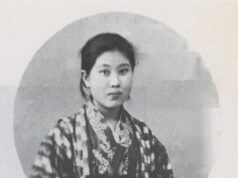The Cycle Regiments

The steep climb up to the Dagshai garrison from National Highway 22 ends at Principal Chowk, in front of the main gate leading to the Army Public School. Going on towards the commanding officer’s house on the southern side of Dagshai hill, one sights the old garrison Anglican Church, still operational, but in a state of considerable disrepair.
The hillside below the church is rocky but has a thick covering of green bush and wild grass. However, a quick scan of the rock face reveals at first glance some kind of an icon, approximately 2×2 feet, with a fresh coat of paint on its periphery. Some four years ago, it was covered by moss and growth, yet to an observant eye it is clear that below lies something which, some years ago, had a human intervention.
A careful scraping away of the growth from the rock face using my trusted Swiss Army knife uncovers an extraordinary engraving depicting an old military insignia that had somehow been long forgotten. On closer inspection, it turns out to be the insignia of the 1/9th Cyclist Battalion of the Hampshire Regiment. Earlier records available about British Army units stationed in Dagshai had no mention about this regiment; however, further research confirmed that this little-known infantry formation was indeed based in Dagshai in 1917.
There was also the more “colourful” 25th (County of London) Cyclist Battalion, The London Regiment, stationed in Dagshai in 1918, with a detachment in Jutogh, near Shimla.
The history of bicycle infantry worldwide, though little known, is quite fascinating. In the mid-1890s, with somewhat more reliable bicycles now riding on pneumatic tyres, several armies experimented with their use to replace horses in military duties, especially as messengers and scouts; in effect, taking over the functions of dragoons (mounted infantry).
The first known use of cycle formations in battle action was by the Dutch Boers during the Second Boer War in South Africa. The US Army used them quite extensively, as did the Germans in World War I and the Japanese in World War II,including during the capture of Malaya and Singapore. The Finnish Army used cyclist soldiers most effectively in their crack Jaeger brigades against the mighty Soviet Army. There are also reports of the Liberation Tigers of Tamil Eelam (LTTE) using cyclist troops during the civil war in Sri Lanka.
In Britain, the development of the cycle corps is generally credited to Lt Col AR Savile, a senior instructor at Sandhurst. Voluntary cyclists were intermittently used during war as early as the 1880s, but the first bicycle unit, the 26th Middlesex Volunteer Rifle Corps, was set up in 1888. After the 1908 reforms, the 26th Middlesex, along with nine cyclist battalions, made up the Army Cycling Corps. By 1915, during WWI, the first of these units were shipped out to France, Flanders and the Gallipoli peninsula.
When and why some of these cyclist formations were sent to India is not quite clearfrom official historical records. However, the 25th London Regiment’s website indicates that the bicycle-borne troops were not found to be terribly effective in the trench warfare in Europe during WWI. Yet it was deemed fit for Indian troops in Flanders to use the bicycles left behind, while the British troops were repositioned to places like Dagshai as conventional infantry.
The 1/9th Hampshires, commanded by Col RA Johnson, were the first to arrive in Dagshai in 1917. Orders for them to proceed for action in Waziristan were rescinded, and they found themselves in the pleasant hill cantonment of Dagshai, with precious little to do except play cycle polo and 6-a-side football, and organise concerts and fancy dress parties.
The 25th London, which replaced the 1/9th Hampshires in Dagshai early in 1918, went a step further. They formed The Dagshai Entertainers, an entertainment group with its own tenor, bass, comedian, pianist, female impersonator, stage and business managers, not to forget a certain Percy C Chisnall, variously described as an elocutionist, drummer and bandsman. Percy, in addition to his histrionic talents, was a keen-eyed photographer. The Dagshai Jail Museum has been fortunate to receive a set of some valuable photographs taken by Chisnall.
Unfortunately, a contingent of the 25th Londons was sent to Amritsar in 1919, during the days leading up to the tragic Jallianwala Bagh incident. Though the regiment was not involved in the actual shooting, its Sergeant Anderson did witness the massacre as he was General Dyer’s personal bodyguard. There is photographic evidence available that the 25th Londons did take part in enforcing the “crawling order”, making Indians crawl on the path where Miss Sherwood had been allegedly attacked.
So, what exactly were the cycling regiments doing in a peaceful Indian hill station cantonment during World War I, that too, without their bicycles? After all, the British Indian Army had provided 1.2 million men—all volunteers, fighting, and dying, for the British at a ridiculous salary of 11 rupees a month! Some 75,000 Indians laid down their lives and around 65,000 were injured in the battlefields of the Somme, Ypres and elsewhere, while some of the tommies were living in comfort in the cool hill stations of India.
The answer is evident in some telling photographs recently released in the UK by official sources as the world prepares for the centenary of World War I: the powers that be in Whitehall wanted to minimise British casualties. The cyclist battalions were packed off to India minus the bikes; it is the Sikh and Gurkha troops of the Indian Army who used these cycles. The desire to minimise British casualties apart, it was deemed essential that well-trained, professional British soldiers were available in various parts of India, just in case political unrest broke out.
The 47th Sikhs (Meerut Division) was one of the first in action at Ypres in October 1914. Of the total 765 men, only 380 were fit enough to stand by November that year. The photograph from the Imperial War Museum, London, of a Sikh havaldar (sergeant) leading a contingent of Indian bicycle troops into battle at Somme, while the British troops watched on from their horses, says it all. Clearly, the Indian troops, accustomed to colonial warfare, were not ready for trench-based fighting, described by many as hellish. As one gallant but anonymous Sikh soldier is said to have quipped at Ypres, “It is not war; it is the end of the world!”
Interestingly, among those fighting side by side with the Indian troops at the battles near Ypres and Somme were the Irish soldiers of the first battalion of the Connaught Rangers (the “Devil’s Own”), as part of the Lahore Division. In 1920, this battalion was posted back to India. These Irish troopers staged the Dagshai mutiny against their English officers, precipitating a chain of events that led to the independence of Ireland and inspired India’s struggle for independence.
~ Anand Sethi has an abiding interest in military history. Co-author of Doing Business in India, he is currently working on The Business of Electronics. Anand lives in Dagshai, Himachal Pradesh, and also a curator of the Dagshai Jail Museum.
In pictures:
1. A Sikh havaldar leads a contingent into battle at a crossroads on the Fricourt-Mametz Road, Somme in July 1916, while the British troops look on from their horses. Another same color picture, colorised by Royston Leonard
2. An engraving depicting the old military insignia of the 1/9th Cyclist Battalion of the Hampshire Regiment in Dagshai




